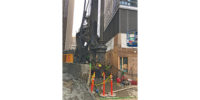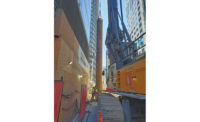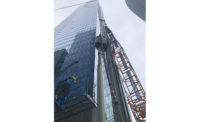Based on further structural analysis and the success of a pilot program that installed three permanent piles using modified procedures, the structural engineer-of-record for the delayed perimeter pile upgrade of the 645-ft-tall Millennium Tower in San Francisco has proposed a significantly reduced scope for the project that he says would still arrest settlement and allow the slow recovery of some of the condominium building’s tilt.
The new scheme would enable Shimmick Construction to complete the pile work early in 2022 and allow the jacking of the loads off the existing foundation before the end of 2022, says Ronald O. Hamburger, the engineer for the $100-million foundation upgrade and a senior principal with Simpson Gumpertz & Heger.
With the reduced scope, Hamburger anticipates the building—which settled 17 in. before the pile work began and 1 in. since—would not settle more than another 1/2 in. before construction is complete. The engineer had halted work on Aug. 20, after the fix designed to stem the tower's settlement had instead accelerated it.
Construction Restart
“We plan to re-initiate construction on 3 January 2022, with the installation of nine additional 24-in. piles required for the proposed reduced-scope project, using the improved procedures demonstrated effective in the recently completed pilot program,” said Hamburger, in a Dec. 28 letter to Neville Pereira, deputy director of permit services for the San Francisco Dept. of Building Inspection (DBI).
“This work will be conducted under the current permit for construction while we work with the [Engineering Design Review Team] and the department to obtain an amendment to the permit for the reduced scope plan,” Hamburger wrote.
Under the revised plan, the number of piles would decrease from 52 to as few as a total of 18 and the loading per pile would increase. The design and installation of the concrete-filled pipe piles, which are within 36-in.-dia steel casings, would not change.
DBI confirms receipt of the letter. “This morning we received the ‘Projection of Building Settlement Through Construction Completion’ from Ron Hamburger and are beginning our analysis," says Patrick Hannan, the department's communications director.
Further Calculations
The recommended new scheme is based on further calculations by Hamburger and John A. Egan, the retrofit’s geotechnical engineer-of-record. In devising the original pile upgrade, the two engineers had never “attempted to optimize the design down to the minimum number of piles necessary,” said Hamburger, in a Dec. 27 letter to James Zaratin, the general manager of the Millennium Tower Association, which represents the owners of the condominium. In that letter, Hamburger informed Zaratin that the Millennium Tower Association board had approved the reduced scope.
For the new approach, Egan and Hamburger evaluated scenarios based on different numbers of piles, starting with the six installed by August. They also evaluated, based on test data from the piles already installed and more detailed structural calculations of the existing foundation's capacity, whether it would be possible to take more load on the new piles than originally planned.
They concluded it is possible to safely increase the load per pile from 800,000 lb to 1 million lb and to achieve the design objectives using as few as 18 piles. “We are presently working with the Department of Building Inspection and their independent review panel to confirm the specific number of piles, which may range from 18 to 24,” said Hamburger in the Zaratin letter.
Douglas Elmets, a spokesperson for the homeowners association, says he has nothing to share at this time on the part of the Millennium Tower Association.
Bypassing Consolidating Soils
The scope of the original perimeter pile upgrade consisted of installing—to rock—52 concrete-filled steel-pipe piles within the steel casings. The piles, spaced 6 ft on center, are going in along the north—Mission Street—and west—Fremont Street—sides of the building. The final step is the jacking of a portion of the building’s weight onto the piles, which would transfer the weight directly to the rock, bypassing the consolidating soils causing the settlement.
Hamburger selected 52 piles because it was the maximum number that could be placed along the building’s sides, where access is readily available. Similarly, he selected the amount of load per pile, 800,000 lb, based on calculations that indicated this was an amount he could safely transfer without damaging the existing foundation.
Shimmick Construction started installing the new piles in May. By August, there had been about 1 in. of settling and tilt, caused by the upgrade. The accelerated movement ceased after Aug. 20, when Hamburger halted the work to establish the revised installation procedures.
Remedial Pilot Program
The remedial pilot program, begun in October, tested two construction activities: 1) installation of a 36-in.-dia steel outer casing to a depth of about 106 ft below grade; and 2) installation of a 24-in.-dia steel-encased, cast-in-place concrete pile down about 270 ft.
Using the modified procedures, Shimmick Construction successfully installed a total of three 36-in.-dia pile casings, each with a 24-in.-dia pile.
To date, Shimmick has installed a total of 36 casings, including 24 on the west side of the tower and 12 on the north side. The contractor has installed a total of nine piles, seven on the west side and two on the north side.
In the Dec. 27 letter, Hamburger reminds Zaratin that the Millennium Tower Association pile upgrade and the late-August pause were both voluntary, based on his determination in 2014 that a structural retrofit was not necessary. The building still “remains safe and able to resist any likely earthquake,” said Hamburger, even with the additional settlement.






Post a comment to this article
Report Abusive Comment